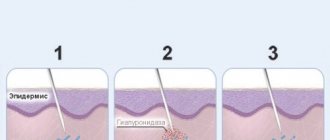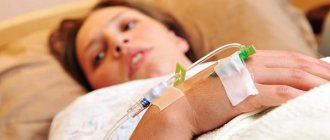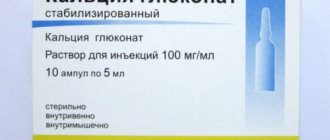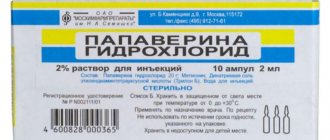What is distillate or water for injection?
The substance is a solvent of medical preparations purified from impurities. The distillate is tasteless, colorless and odorless. It is chemically inert, does not contain foreign organic components and does not affect the water-salt balance of the body.
Water for injection, saline, and other excipient fluids used in clinical practice serve to dilute parenteral drugs or act as a diluting agent to reduce the concentration of potent pharmacologically active compounds.
Medical distillate is produced in ampoules made of glass or chemically neutral polymer material with different filling volumes. The recipe and technology for manufacturing a simple substance is extremely complex.
Through special multi-stage filtration, distilled water for medical use is purified from:
- salts;
- gaseous impurities;
- mechanical inclusions;
- microorganisms;
- pyrogenic molecules.
For clinical use, the substance is rendered completely sterile. One of the methods for obtaining medical distillate is reverse osmosis. This is the process of passing a source liquid through a semi-permeable membrane at a precisely calculated pressure.
How does water for injection differ from saline solution?
Substances are used in clinical practice for various purposes. The main difference between aqueous distillate and saline solution is the chemical formula. The latter has a more complex composition and is capable of performing many functions.
The saline solution contains dissolved chemical compounds and salt components, which in consistency correspond to the plasma fraction of the blood. When administered intramuscularly, such a substance causes pain due to its relatively high density.
Distilled water is not suitable for infusion. Only physiological solution is used, which allows dissolving biochemically active compounds in a large volume of neutral liquid.
This substance is available in glass or polymer bottles of 150, 200 and 250 ml, and water for injection is available only in ampoules. Saline solutions come in different types, compositions and purposes. The scope of application of medical distillate is more scarce and limited.
Physiologically, the solution facilitates the body’s sensitivity to potent drugs and accelerates their absorption. Water for injection is completely devoid of such properties. It has no side effects, but can disrupt the water-electrolyte balance in children.
Methods of application
Distilled water is used exclusively for intramuscular, intradermal and intravenous administration of drugs. Sometimes it is used to wash wound surfaces, during surgical operations, and to moisten dressings.
The saline solution for infusion should have a temperature of +36…+38°C. When installing a substance by drip, the patient’s body weight, age and diagnosis are taken into account. The average daily dose for an adult is 500 ml of saline solution.
The maximum permissible intravenous infusion rate is 70 drops/min. The throat, sinuses, and stomach are washed with saline solution. It is used to cleanse the intestines. The substance is used for diluting inhaled drugs and for other therapeutic, diagnostic and prophylactic purposes.
Classification of water for injection
Medical distillate is divided into several types depending on the chemical composition and method of production. The substance has pyrogen-free properties and does not contain antimicrobial preservatives or other impurities.
Water for injection (saline solution has its own more complex classification) is a colorless, transparent and chemically inert liquid.
Established technical parameters of medical distillate, common to all varieties:
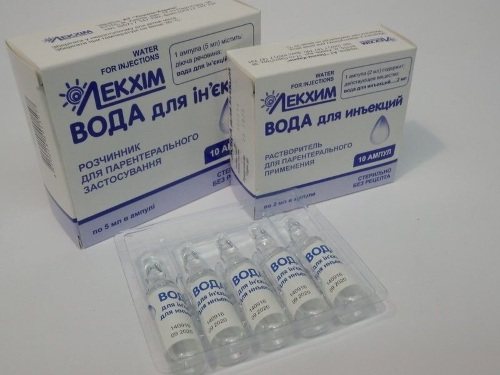
Water for injections
| Characteristic | Meaning |
| pH value | 5,0-7,0 |
| Electrical conductivity | 5·10−4 S/m at a temperature of +20°С |
| Electrical resistance | 2 kOhm⋅m |
| Microbiological purity | Up to 10 CFU/100 ml |
| Bacterial endotoxins | Less than 0.25 EU/ml |
| Dry residue | 5 mg/dm3 |
| Ammonium | 0,00002% |
| Aluminum ions | No more than 0.00001% |
| Heavy metals | Up to 0.00001% |
Medical distilled water should not contain silicon dioxide, calcium, or sulfates. It is purified from nitrates, chloride compounds and other impurities using various technological methods.
According to the method of production and receipt
Chemically neutral liquid for dissolving injectable drugs is produced in 4 main ways:
- Reverse osmosis. This technology consists of passing the starting substance through a semi-permeable membrane to create a certain compression load. It serves as a kind of filter that only water molecules and smaller substances can overcome.
- Antiseptic distillation. The starting liquid is heated to +80°C. This temperature is detrimental to most microorganisms. As a result, disinfection occurs. The liquid is then evaporated and condensed, thereby freeing it from heavy impurities with a higher boiling point.
- Ion exchange. The method involves starting a reversible chemical reaction in a homogeneous environment. The procedure is performed using a special laboratory column-type installation. This method allows you to eliminate chemical impurities and salt components.
- Electrodialysis. The technique is aimed at separating salts and other impurities from a solution using currents of a given strength and voltage.
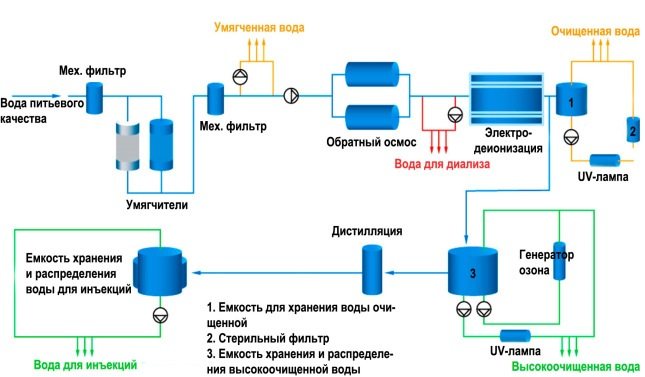
Reverse osmosis technology does not purify water from herbicide and chloride compounds. Therefore, complex methods of distillation of medical liquid are used.
By chemical composition
Water for injection, unlike saline solution, is an absolutely sterile liquid. It does not have pharmacological properties and a multicomponent chemical composition. The volume of foreign inclusions in it is negligible. The only chemical compound of such a liquid is H2O.
Treatment of the injection field
The injection field is the place where the injection will be made and the surrounding tissue.
Before carrying out such a procedure, medical personnel perform hand hygiene using liquid antibacterial soap (“Septolite Antimicrobial Soap”) and water, disinfect with a skin antiseptic spray (“Septolite Antiseptic”), dry their hands and put on sterile gloves.
According to the technology of invasive interventions in accordance with GOST 52623.4-2015 and methodological recommendations, the injection field is processed in the following order:
- Moisten 2 sterile gauze wipes (cotton balls) with an alcohol antiseptic solution;
- wipe the site of infestation with movements in the same direction twice;
- wait for the end of the exposure time of 1-2 minutes (for “Septolite Antiseptic” 1 minute) and complete drying;
- make an injection.
Indications for use
The medical substance is used as a neutral carrier or diluent solution for the preparation of injectable medications produced in dosage forms not intended for administration in pure form.
Lyophilisates, powder mixtures and liquid concentrates are diluted with distilled water.
The substance is used externally for treatment:
- open wounds;

Treatment and treatment of purulent wounds - burn surfaces;
- frostbitten areas of the skin;
- ulcers and boils.
In some cases, water for injection is used to moisturize dry lips and mucous membranes.
General description of injection liquid
This composition is sterile. It is used for the manufacture of medicinal mixtures and is characterized by the following properties:
- complete absence of microorganisms;
- use as a drug solvent;
- strict production conditions with mandatory treatment of containers with hot steam;
- short shelf life;
- special conditions under which storage is carried out.
Injection water is tasteless and colorless. This liquid has no odor.
Rules for using distillate
When mixing medical distilled water with a powder composition or liquid concentrate, you need to visually monitor the consistency and condition of the resulting substance.
Pharmacological incompatibility is possible. It is signaled by the formation of a cloudy precipitate or other unacceptable change in the given structure of the medicinal solution. If the osmotic pressure is reduced, direct intravascular injection is not performed.
In such a situation, there is a risk of hemolysis - destruction of red blood cells with excessive release of hemoglobin. The rules of sterility and antiseptics should be observed at all stages of using the liquid - from opening the ampoule to injection of the diluted drug.
What is strictly prohibited to use
Often, when looking for something that can replace alcohol for injections, they think of alcohol. But you can use vodka, whiskey and other strong alcoholic drinks only as a last resort.
Vodka is not suitable as an antiseptic, since it has a low degree for disinfection. Sweet liqueurs are not suitable. Sugar from the surface of the skin will mix with the medicinal solution and enter the blood. When you urgently need to measure your sugar level, a sweet liquid will affect the result. In addition, skin irritation will occur. Factory tinctures use low quality alcohol
Source
Instructions for use and doses of water for injection
The volume of distilled liquid and the rate of administration are determined by the instructions for the diluted drug. The ampoule is opened with a cotton swab soaked in an antiseptic alcohol solution.
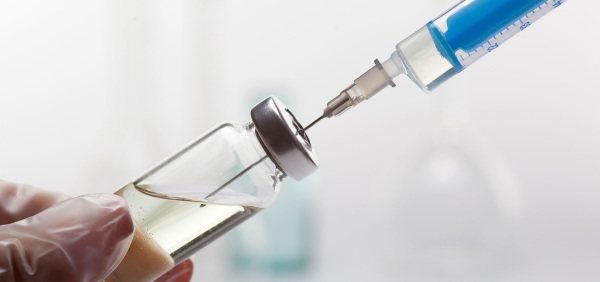
Water for injection is taken with a disposable sterile syringe, the sealed packaging of which is opened immediately before the procedure. Such precautions help prevent contamination of the liquid by pathogenic or opportunistic microflora.
The permissible daily volume of water for injection is calculated individually by the doctor based on the clinical need and the dosage of the drug being mixed. The minimum, average and maximum therapeutic doses of the substance have not been established due to its lack of pharmacological activity and noticeable effect on the body.
Overdose
Such cases have not been described in clinical practice. Overdose is considered impossible due to the lack of biochemical activity and pharmacodynamic properties of distilled water.
Theoretically, an excess volume of neutral fluid in the blood can lead to a change in its rheological characteristics towards a decrease in viscosity. In practice, this is not feasible, since the medical distillate is mixed with potent drugs that will more quickly provoke drug intoxication syndrome.
Interchangeability of water for injection and saline solution
These substances have different characteristics and purposes. In most cases, they are not interchangeable, since each drug is designed to be combined with a specific type of neutral carrier. This is due to the pharmacokinetic properties and chemical structure of its constituent components.
Water for injection, saline solution are medical liquids belonging to the category of isotonic solutions. Some potent drugs suggest the possibility of combination with any of them. This mainly applies to drugs for intramuscular injection.
The chemical neutrality of such liquids prevents interaction with the components of any medications. They are interchangeable mainly for external processing and for technical needs - wetting dressings, moisturizing the epidermis, wiping contact lenses and medical instruments.
Use during pregnancy and lactation
The manufacturer does not prohibit the use of the drug during women's pregnancy or lactation. The risks of treatment during these periods are directly determined by the nature of the second medicinal substance, which is dissolved in the liquid for further administration.
Does not lead to any adverse consequences for either the pregnant woman or her fetus or newborn child.
Overdose and its consequences
If you use the product for its intended purpose, the risk of overdose or other adverse effects is zero.
The manufacturer draws attention to the possibility of provoking hemolysis. It is the destruction of red blood cells with the release of hemoglobin into the environment. This problem occurs when large volumes of hypotonic solutions are infused.
The problem of using water for injection can arise if a large number of drugs aimed at lowering blood pressure are dissolved in it. Signs and characteristic symptoms of overdose are not directly related to the use of water for injection. They are based only on those medications that are used to dissolve in a given sterile liquid.
Popular Is it possible to become a genius thanks to piracetam injections?
When can you not replace distillate with saline and vice versa?
For intravascular injections, only saline solution is used. Distilled water is not suitable due to the lack of organic components that reduce osmotic pressure. This liquid is not used for infusion of medications and intravenous installation. For these purposes, use exclusively saline solution.
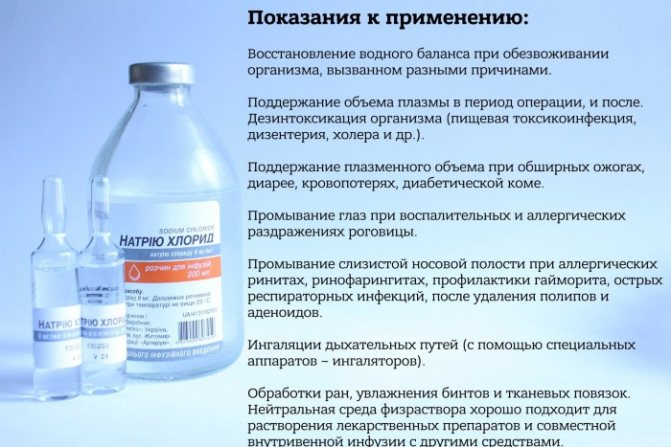
You can’t do without it when:
- the need to regulate the functional state of body systems;
- restoration of blood fluid volume after surgery;
- suppression of the inflammatory process;
- disinfection of open wounds;
- washing the eyes in case of allergic drying of the mucous membrane;
- mixing inhaled drugs.
In these cases, water for injection is not suitable. It is used for the manufacture of some dosage forms - antiseptic solutions, eye drops, ointments for external use.
Antiseptic solutions - analogues of alcohol
Instead of ethyl, you can use medical alcohol solutions:
- aseptolin;
- boric;
- formic;
- camphor;
- alcohol tinctures;
- alcohol solution of salicylic acid;
- chloramphenicol alcohol;
- Furacilin.
Pharmacy tinctures of calendula and valerian contain 70% alcohol.
Alternative antiseptics:
- chlorhexidine;
- iodine;
- brilliant green;
- hydrogen peroxide 3%;
- carbolic acid.
Alcohol wipes are similar to wet cosmetic wipes, only they are soaked in alcohol. Cosmetic wipes are not suitable as they do not contain enough alcohol. An aqueous solution of chlorhexidine is considered an even better antiseptic than ethyl. It is used in cosmetology, in particular for mesotherapy and other beauty injections.
Non-traditional disinfectant liquids – triple cologne, perfume. Aniline dyes are suitable if alcohol liquids are not available. Also, in an emergency, you can clean the injection site with mouthwash.
Doctors also advise using Bactosin, Decasan, Octenisept, Unisept.
Cost of water for injection and saline solution in pharmacies, trade names
The price of such liquids is low and available to a wide range of potential buyers.
Cost of common types of distilled water:
- Bufus – 93 rub. per pack of 10 ampoules of 2 ml;
- Super Amp – 62 RUR. for 10 ampoules of 5 ml;
- Vial is a domestic product sold in pharmacies for 33 rubles. per pack;
The variety of saline solutions from domestic and foreign manufacturers is much greater.
You can freely buy in pharmacies:
- Sodium chloride – 40 rub. per bottle of 200 ml;
- Aqua Master - isotonic solution used for rinsing the nose, cost 95 rubles;
- Physiology – 70 rubles;
- Salin is an isotonic solution based on sodium chloride, costs 193 rubles;
- Rizosin – 73 rub.
Neutral medical liquids in the form of water for injection have a narrower therapeutic specialization than saline solutions based on sodium chloride or other chemically inert compounds. The cost of these substances depends on the manufacturer and country of manufacture.
What skin antiseptics exist?
Antiseptic products for treating the skin are available in different versions: sprays, gels, solutions, aqueous emulsions, wipes soaked in disinfectant in individual packages.
Disinfectants based on alcohol (ethyl, methyl, isopropyl), chlorhexidine, miramistin, furatsilin, chloramphenicol are used.
Which antiseptic for injections is better?
Alcohol antiseptics are considered the best for disinfecting the injection field and disinfecting hands.
The Russian company Satellite produces disinfectants based on 60-70% isopropyl alcohol, which have a wide spectrum of action against most viruses, bacteria and fungi, have a short exposure time (1 minute), and are approved for use by Rospotrebnadzor. They do not have a sensitizing or local irritant effect.
“Septolite Antiseptic” is a liquid product in the form of a spray with prolonged additives and skin-softening components (available in convenient plastic bottles with a volume of 100 ml to 1 liter with a dispenser);
“Septolite Antiseptic Napkin” - each napkin contains 3 g of Septolite Antiseptic based on isopropyl alcohol (packaged in bags of 50 pieces in individual packaging or in jars of 60 pieces in a perforated roll).
Source

